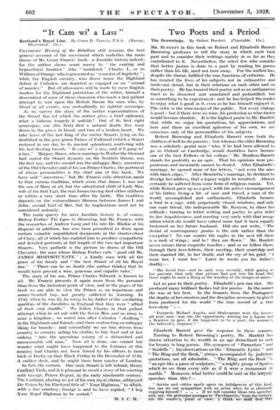Scotland's Royal Line. By Grant R. Francis, F.S.A. (Murray. Illustrated.
21s.)
CHAMBERS' History of the Rebellion still remains the best general account of the movement which underlies the main theme of Mr. Grant Francis' book—a Jacobite history indeed ; for the author shows scant mercy to " the canting and hypocritical fanatics " who. ." murdered " Charles I., or to William of Orange, who is presented as " a master of duplicity " ; while the English cavalry, who drove home the Highland defeat at Culloden, are depicted as engaged on an " errand of murder." But all allowances will be made by mere English readers for the Highland patriotism of the writer, himSelf descendant of some of those clansmen who made a last gallant attempt to seat upon the British throne the man who, by blood at all events, was undoubtedly its rightful sovereign.
As we survey the story of the earlier repreientatives of the Stuart line (of which the author gives a brief epitome), what a hideous tragedy it unfolds ! Out of its first eight sovereigns, one (the first) died a natural death, five went down to the grave in blood, and two of a brekeri heart. We take leave of the last king of the earlier StuartS lying on his deathbed in the grey-green Palace of Falkland (which a Stuart restored in our day to its ancient splendour), muttering with his fast-fleeting breath, " It cam wi' a lass, and it'll gang wi' a lass." Marjory Bruce, whose marriagetb Walter the Steward had seated the Stuart dynasty on the Scottish throne, was
the first lass, and the second was the unhappy Mary,.ancestress of the Old Chevalier and of his son Prince. Charles, the portrayal Of whose personalities is the chief aim of this book. We have said `* ancestress," but Mr. Francis calls attention again to that curious tradition, which avers that James I. was not the son of Mary at all, but the substituted child of Lady Mar, wife of the first Earl, the real James having died either stillborn Or within a very short time after his birth. The tradition depends on the extraordinary likeness between James I. and ',John, second Earl of Mar, but its implications need not be considered seriously.
The main quarry for later Jacobite history is, of course, Bishop Forbes' The Lyon in Mourning, but Mr. Francis, with the researches of Andrew Lang and the late Dr. Blaikie at his disposal in addition, has also been permitted to draw upon certain valuable unpublished documents in the charter-chest of Cluny, all of which has enabled him to produce sympathetic and detailed portraits-at Sun length of the two last important Stuarts. Very pathetic is the picture he draws of the Old Chevalier, the man whom Bishop Forbes calls " good old Mr. 'JAMES MISFORTUNATE " ; a kindly man with all the grace of his family and " the best Stuart of all his Royal
line." There can be no doubt. (the author thinks) that he would have proved a wise, generous and capable ruler."
• The story of his son, Prince Charles Edward, is known to all. Mr. Francis presents it again . more, from the personal than from the historical point of view, and in the pages of his book we are able to view the Prince as an impetuous and sunny-hearted boy, not greatly addicted to learning. In .1745, when he was 25, he wrote to hi.; father of the vacillating qualities of the Jacobites in England that they were " affred of their own shaddo." We -follow Charles in that gallant
.attempt when he set out with the Seven Men .and no army to seize a kingdom ; we watch him after Culloden " Skulking " in the Highlands and Islands, and there contracting an unhappy liking for brandy ; and sorrowfully we sec him driven from country to country selling his clothes to buy food and at last sinking ** into the querulous misery of a debauched and
unreasonable old man." Now all is done, one cannot but .wonder what might have happened to the fortunes of this country had Charles not been forced by his officers to turn back at Derby on that Black Friday in the December of 1745.
A sudden dash, and he might have been master of London. So falls the curtain. One male. Stuart. is leftbehind,. Henry Cardinal York, and it is pleasant to recall a story of his meeting with George, Prince Regent, in the early nineteenth century. The Cardinal, abating no jot of his own royal claims, addressed the Prince by his ElectOral title of " YOur Highness," to iaiich, with a fine courtesy, George is said to have replied, " I beg :Your Royal Highness to be seated." . . •
sM: '


















































































































 Previous page
Previous page